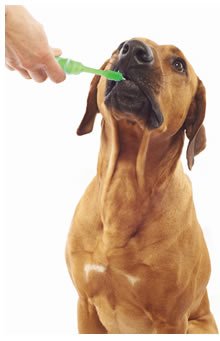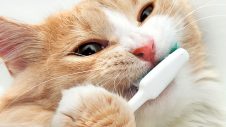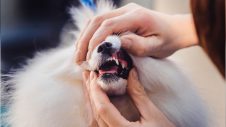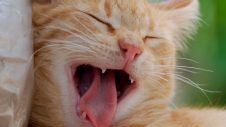Why do my pet’s teeth need cleaning?
Dental disease is one of the most common ailments seen by vets. It presents as one or more of the following symptoms:
- Gingivitis (inflammation of the gums)
- Tartar accumulation (a combination of food, saliva, bacteria and hair)
- Tooth enamel damage.
The buildup of tartar (brown-green material) on teeth and under the gum line causes pain and infection. If left unchecked, the infection can spread to surrounding bone and enter the bloodstream, causing general health deterioration. Once periodontal disease starts, the changes are irreversible, and it becomes easier for more plaque and tartar to accumulate, leading to a worsening of the disease.
There are many different methods to prevent dental disease and assist with dental hygiene at home, some of which include:
- Regular brushing
- Treats and chews
- Dental diets
- Dental toys.
If your pet has any accumulated tartar (calculus), it must be removed by your veterinary surgeon. This process, called prophylaxis (or scale and polish), will allow you to start your home care with teeth that are free from plaque and tartar and will make your efforts easier and more effective.
Daily brushing of your pet’s teeth should not be underestimated. Commitment to daily brushing could be what makes the difference to your pet’s health and sparkly smile.
Brushing your pet’s teeth should be a pleasant experience for you and your pet. Many pets enjoy the added attention, while many owners look forward to close, quality time spent with their companion.
You will need a toothbrush or fingerbrush (preferably one designed for pets) and pet toothpaste. Most pets accept brushing very well if they are introduced to the procedure in a calm and patient way. The best way to introduce your pet to this exercise is gradually over time.
The 7-day teeth brushing challenge:
DAY 1:
Gently pet and scratch the muzzle, slowly lifting the lip for about 30 seconds. At the end of the session, reward with praise and a treat.
DAY 2:
Repeat as above, and also gently run your finger or finger toothbrush and a small amount of animal toothpaste over your pet’s teeth for 30-45 seconds. Reward with a treat and praise.
DAY 3:
Repeat day 2, adding 15 seconds of time and running your finger or finger toothbrush over your pet’s teeth. Always reward with praise and a treat.
DAY 4:
If all is going well, run your finger over the teeth for 30 seconds, gently insert the toothbrush, and run over the teeth again for 30 seconds.
DAY 5:
Repeat as day 4 and increase the time by 30 seconds.
DAY 6:
Repeat as day 5 and gently rub your pet’s teeth.
DAY 7:
You know your pet best. If you feel that your pet is not accepting the brushing well, gradually increase the brushing time until you can spend at least one minute on each side of the mouth.
If the animal resists at any time, stop and wait until the next day. If your pet still does not accept your efforts, contact your Greencross Vets pet care team for more advice.
Helpful hints….
- Be patient. Take time with the process, or your pet will become resistant.
- Give lots of praise. It’s a new experience for you and your pet; praising them will make them more receptive.
- Always put a small amount of animal toothpaste on your finger or toothbrush. Your pet will like the taste and associate the good taste, treats and praise with having their teeth brushed.
- Reward your pet with treats at the end of each session.
- Stop immediately if there are any signs of aggression.
- Human toothpaste is for humans, not for pets.
- Remember, always make it fun!
What should I do if my pet is showing signs of dental problems?
If your pet shows signs of dental disease or mouth discomfort, they should be checked by your vet. You will be advised of the most appropriate course of treatment.
If your pet’s teeth require cleaning, it is more involved than simply removing visible tartar from the tooth surface. The first step is a general examination of the mouth and back of the throat. Any teeth that need removing are noted at this stage.
Next, a fine probe is used to explore under the gums on all sides of the tooth, looking for any tooth deficits or evidence of jawbone erosion. Worn teeth are also checked to ensure that the pulp cavity (inner core) is not exposed, which can cause pain.
The first stage of cleaning is to remove any thick, heavy tartar buildup. A hand scaler is then used to remove any finer particles of tartar from the tooth. Next is the most critical stage: a curette is used to clean any tartar, hair, or debris under the gumline. It is this material under the gumline that leads to the progression of dental disease and all of its associated health risks.
Once the hand cleaning is completed, an ultrasonic scaling machine is used to clean the exposed tooth surface. This machine is similar to those used by human dentists and uses sound waves to remove very small or invisible particles of tartar. Finally, the teeth are polished using a polishing paste and a soft rubber cup, once again identical to that used by our own dentists. The teeth are polished to restore their original smooth surface, which resists tartar build up.
After teeth are cleaned, any that require removal are extracted. Some of the larger teeth may need to be cut into several pieces to be removed, or gums may need to be cut to get them out. In some cases, the hole left from an extracted tooth will be stitched.
Once all necessary teeth are removed, the mouth is flushed with an antiseptic. Pets are usually given antibiotics by injection and, in certain circumstances, sent home with continuing tablets or capsules. If any teeth have been extracted, a checkup will be required to ensure that the gums are healing well.
Contact your local Greencross Vets for more information on keeping your pet’s teeth healthy at home.

 Greencross Vets
Greencross Vets 











